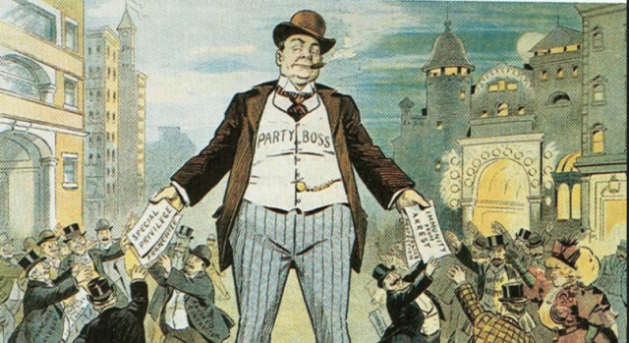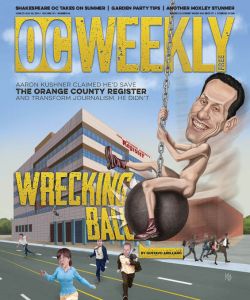
Jeff Bezos was right. Photo by Grant Miller for the George W. Bush Presidential Center.
Previously published at WGBHNews.org.
As newspapers have moved away from making their content freely available online, a lot of thinking that seemed forward-looking a few years ago needs to be re-examined. Near the top of the list is the future of the newspaper bundle — that combination of local, national and international news, sports, comics, the crossword puzzle, the school lunch menu and myriad other features that traditionally comprised a daily newspaper.
In the early years of online news, when it seemed reasonable to imagine that digital advertising could subsidize free journalism, the bundle was often described as a relic of the industrial age. Disparate content was brought together, according to this line of reasoning, not because it belonged in one place but because printing was a high-cost manufacturing enterprise. It was logical for the local newspaper to be a one-stop destination for all kinds of material. But with print receding into the past, readers could skip from a hyperlocal website for community news, to a dedicated sports site, to yet another site for comics and puzzles,
“The web wrecks horizontal integration,” wrote C.W. Anderson, Emily Bell and Clay Shirky in their influential 2012 report “Post-Industrial Journalism.” “Prior to the web, having a dozen good-but-not-great stories in one bundle used to be enough to keep someone from hunting for the dozen best stories in a dozen different publications. In a world of links and feeds, however, it is often easier to find the next thing you read, watch or listen to from your friends than it is to stick with any given publication.”
But at a time when readers are once again being asked to pay for newspaper journalism, some sort of bundling is necessary. The days of regularly surfing among multiple free websites are drawing to a close. For any one newspaper to stand out as something to which readers will be willing to buy a subscription, it almost certainly has to offer a wide variety of content.
From the newspaper business’ point of view, the ideal reader would buy digital subscriptions to national, regional and local newspapers. But that’s asking a lot. The reality is that most people aren’t going to subscribe to any newspaper, and those who do are likely to choose one, maybe two. Which means that the newspaper needs to be all things to most people in a way that we thought was obsolete just a few years ago.
In early 2016 I interviewed Bill Marimow, the editor of The Philadelphia Inquirer, days after its billionaire owner, Gerry Lenfest, had donated the Inquirer and its related media properties to a nonprofit organization. (The Philadelphia story comprises a section in my 2018 book “The Return of the Moguls.”) The Inquirer was just getting ready to start charging for digital subscriptions. And I was struck by what Marimow told me he thought needed to be part of the daily mix.
“If you look at today’s paper,” he said, “you’ll see stories that represent the best of city news, Philadelphia suburbs, South Jersey, national and foreign.” I expressed some surprise at Marimow’s insistence on national and international news since the Inquirer relied almost exclusively on wire services for anything outside the Philadelphia area. His answer was that 90% of his readers did not read a national paper and thus relied on the Inquirer.
You see this at The Boston Globe, too. Before the internet began to take a toll on the newspaper business in the 1990s, the Globe — and many other large regional newspapers, including the Inquirer — had a number of U.S. and international bureaus. With the exception of a Washington bureau, those are all gone now. But the Globe continues to publish quite a bit of national and international news from wire services, both in print and online.
Ten years ago, that would have been described as old-media thinking. Now, with the Globe charging $30 a month for digital subscriptions, it makes a great deal of sense to position the paper as a single stop for most of its customers. After all, if the Globe forced its best readers to subscribe to The New York Times, The Washington Post or The Wall Street Journal in order to get news from beyond the Boston area, there’s a real danger that they would decide to drop the Globe.
When Jeff Bezos bought The Washington Post in 2013, he announced that he wanted to reinvigorate the traditional newspaper bundle. “People will buy a package,” Bezos said. “They will not pay for a story.” Bezos’ attitude seemed archaic for someone who had made his reputation as a tech visionary. One of the Post’s younger journalists, Timothy B. Lee, went so far as to disagree with his new boss in a piece headlined “Sorry, Jeff Bezos, the news bundle isn’t coming back.”
“Trying to recreate the ‘bundle’ experience in Web or tablet form means working against the grain of how readers, especially younger readers, consume the news today,” Lee wrote. “In the long run, it’s a recipe for an aging readership and slow growth.”
It turned out that Bezos was right and Lee was wrong — not because Lee was mistaken about how the web had changed news habits, but because paywalls were going up everywhere, thus forcing a change in those habits whether readers liked it or not. Under Bezos’ ownership, the Post’s digital bundle has led to profits and growth, re-establishing the paper as a serious competitor to the Times.
With Google and Facebook capturing the vast majority of digital advertising in recent years, paid content has become the last stand. It may not work for more than a handful of mostly national titles. But, if nothing else, paywalls have given new life to the idea of the bundle that has traditionally defined the general-interest newspaper.








